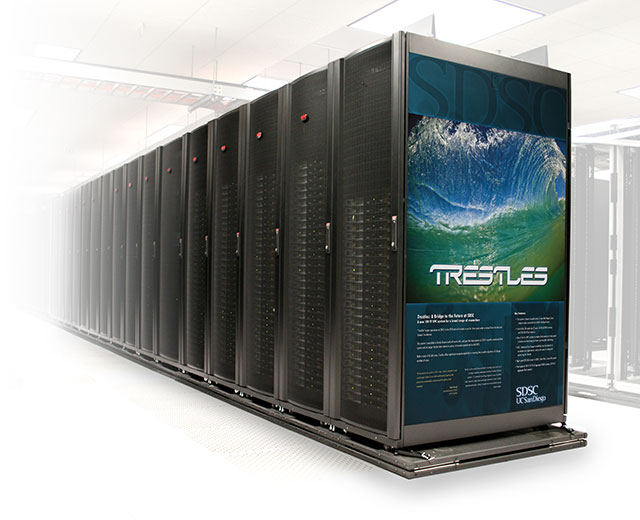

 Skip to navigation
Skip to navigation
Site Primary Navigation:
- About SDSC
- Services
- Support
- Research & Development
- Education & Training
- News & Events
Search The Site:

Published May 5, 2015

SDSC’s ‘Trestles’ supercomputer Image: Ben Tolo, SDSC.
The National Science Foundation and the San Diego Supercomputer Center (SDSC) at the University of California, San Diego, have agreed to transfer ownership of its Trestles supercomputer cluster to the Arkansas High Performance Computing Center.
Once installed, the supercomputer will more than double the Arkansas High Performance Computing Center’s computational capacity and allow it to run three times the amount of jobs for campus researchers, according to David Chaffin and Jeff Pummill, interim co-directors of the center. The University of Arkansas announcement can be read here.
“We are thrilled to acquire a prominent national resource for high-performance computing,” said Pummill. “Researchers at the University of Arkansas are in a perpetual state of evolution and advancement in their computational needs, and Trestles is known throughout the national high-performance computing community as a ‘high-productivity workhorse.’”
“High-performance computing (HPC) plays a pivotal role in supporting vital research at the University of Arkansas,” said Jim Rankin, vice provost for research and economic development at the university. “The addition of Trestles enhances our goal of becoming one of the top 50 public research universities in the United States.”
Added Richard Moore, SDSC’s deputy director and the principal investigator for Trestles: “During its four-year run at SDSC, Trestles successfully supported thousands of national researchers with modest-scale applications as well as science gateways, with shorter turnaround times than has been typical for most HPC systems. It’s terrific that this resource can be re-deployed to advance scientific research at the University of Arkansas.”
In 2010, the NSF awarded $2.8 million to SDSC and UC San Diego to deploy Trestles. Since it went online, the supercomputer has been recognized as the leading science gateway platform in the NSF’s eXtreme Digital (XD) Network, a collaborative set of compute and storage resources in the U.S. that scientists can use for advanced computational and data-enabled research. The collected facilities, integrated by the NSF’s XSEDE (eXtreme Science and Engineering Discovery Environment) program, offer researchers access to a network of supercomputers and high-end visualization and data analysis resources across the country.
Pummill, through his connections with XSEDE, became aware last year that Trestles would be decommissioned in 2015 as SDSC began early operations of its new petascale Comet supercomputer. The parties verbally agreed to the transfer last summer. Prior to installing Trestles, the University of Arkansas will decommission its supercomputer known as the Star of Arkansas to make room for the new supercomputer. The Star of Arkansas was activated in 2007 and at one time was the most powerful computer in the state.
About the University of Arkansas
The University of Arkansas provides an internationally competitive education for undergraduate and graduate students in more than 200 academic programs. The university contributes new knowledge, economic development, basic and applied research, and creative activity while also providing service to academic and professional disciplines. The Carnegie Foundation classifies the University of Arkansas among only 2 percent of universities in America that have the highest level of research activity. U.S. News & World Report ranks the University of Arkansas among its top American public research universities. Founded in 1871, the University of Arkansas comprises 10 colleges and schools and maintains a low student-to-faculty ratio that promotes personal attention and close mentoring.
About SDSC
As an Organized Research Unit of UC San Diego, SDSC is considered a leader in data-intensive computing and cyberinfrastructure, providing resources, services, and expertise to the national research community, including industry and academia. Cyberinfrastructure refers to an accessible, integrated network of computer-based resources and expertise, focused on accelerating scientific inquiry and discovery. SDSC supports hundreds of multidisciplinary programs spanning a wide variety of domains, from earth sciences and biology to astrophysics, bioinformatics, and health IT. SDSC’s Comet joins the Center’s data-intensive Gordon cluster. SDSC is a partner in XSEDE (eXtreme Science and Engineering Discovery Environment), the most advanced collection of integrated digital resources and services in the world.
Share